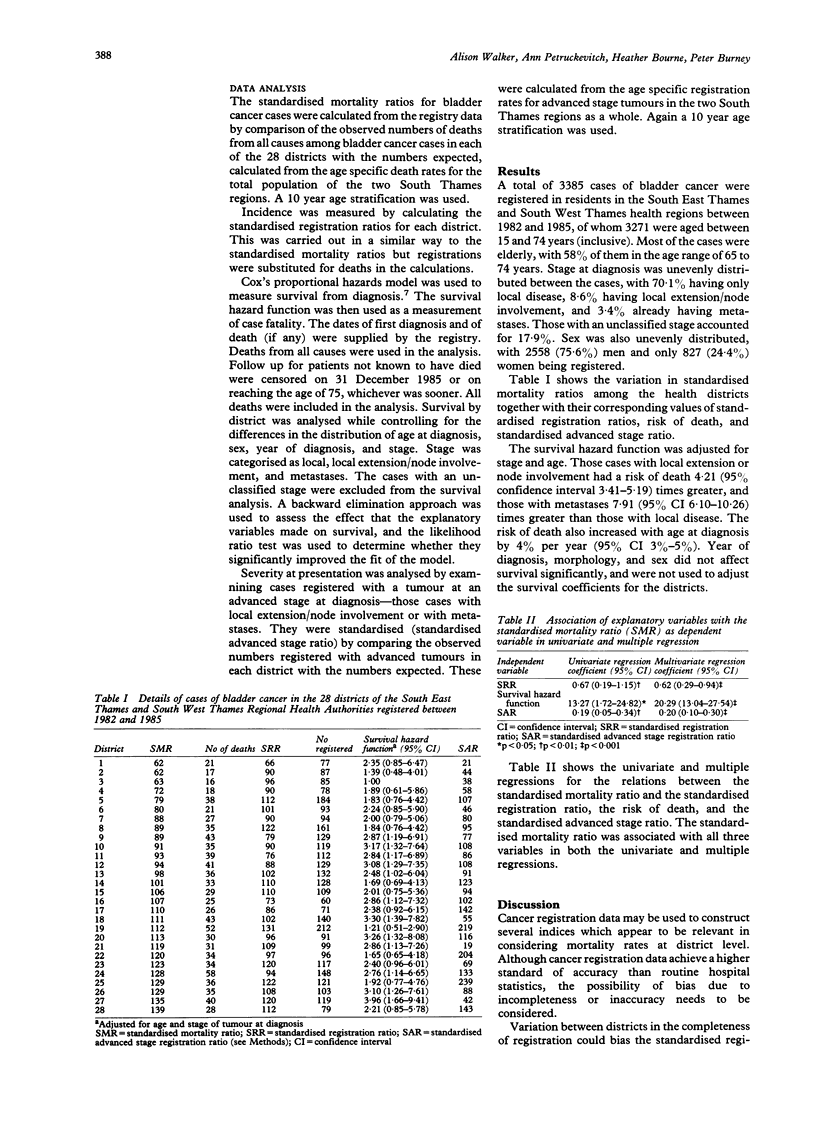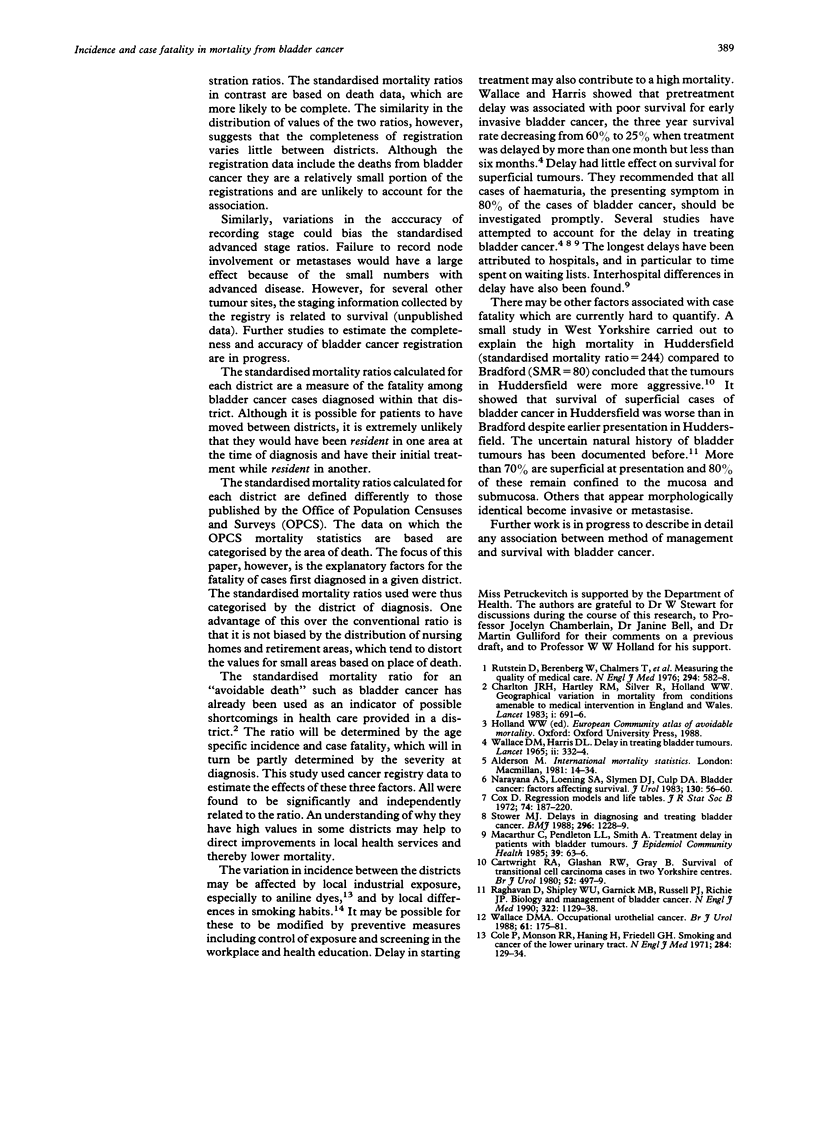Abstract
STUDY OBJECTIVE--The aim was to assess the individual contributions of incidence and case fatality to variations in bladder cancer mortality between districts in the South Thames Regions. DESIGN--The standardised mortality ratios for bladder cancer were calculated for the health districts in the South Thames Regions using data from the Thames Cancer Registry. The results were compared with the standardised registration ratios, used as a measurement of incidence, and survival hazard function, used as a measurement of case fatality. As one determinant of case fatality is the severity at presentation, mortality was also compared with the standardised proportion of cases with advanced disease at diagnosis. SETTING--The study took place in the 28 health districts in South East and South West Thames regional health authorities. SUBJECTS--Subjects were 3271 cases of bladder cancer aged 15-74 years resident in one of the two South Thames regional health authorities at diagnosis and registered between 1982 and 1985. MAIN RESULTS--The standardised mortality ratios for the different districts varied from 62 to 139. The standardised registration ratios, the survival hazard functions adjusted for age and stage of disease at diagnosis, and the proportion of cases with severe disease at diagnosis were all independently and significantly related to the standardised mortality ratios in each district. CONCLUSIONS--Mortality from bladder cancer was significantly related to measurements of incidence, case fatality, and severity at presentation. These relations have implications for the health services. The incidence of disease may be modified through preventative measures, the case fatality through improved quality of care, and severity at presentation possibly through prompt management of patients with haematuria. Further studies are needed to investigate why these factors have high values in some districts.
Full text
PDF


Selected References
These references are in PubMed. This may not be the complete list of references from this article.
- Cartwright R. A., Glashan R. W., Gray B. Survival of transitional cell carcinoma cases in 2 Yorkshire centres. Br J Urol. 1980 Dec;52(6):497–499. doi: 10.1111/j.1464-410x.1980.tb03099.x. [DOI] [PubMed] [Google Scholar]
- Charlton J. R., Hartley R. M., Silver R., Holland W. W. Geographical variation in mortality from conditions amenable to medical intervention in England and Wales. Lancet. 1983 Mar 26;1(8326 Pt 1):691–696. doi: 10.1016/s0140-6736(83)91981-5. [DOI] [PubMed] [Google Scholar]
- Cole P., Monson R. R., Haning H., Friedell G. H. Smoking and cancer f the lower urinary tract. N Engl J Med. 1971 Jan 21;284(3):129–134. doi: 10.1056/NEJM197101212840304. [DOI] [PubMed] [Google Scholar]
- MacArthur C., Pendleton L. L., Smith A. Treatment delay in patients with bladder tumours. J Epidemiol Community Health. 1985 Mar;39(1):63–66. doi: 10.1136/jech.39.1.63. [DOI] [PMC free article] [PubMed] [Google Scholar]
- Narayana A. S., Loening S. A., Slymen D. J., Culp D. A. Bladder cancer: factors affecting survival. J Urol. 1983 Jul;130(1):56–60. doi: 10.1016/s0022-5347(17)50952-0. [DOI] [PubMed] [Google Scholar]
- Raghavan D., Shipley W. U., Garnick M. B., Russell P. J., Richie J. P. Biology and management of bladder cancer. N Engl J Med. 1990 Apr 19;322(16):1129–1138. doi: 10.1056/NEJM199004193221607. [DOI] [PubMed] [Google Scholar]
- Rutstein D. D., Berenberg W., Chalmers T. C., Child C. G., 3rd, Fishman A. P., Perrin E. B. Measuring the quality of medical care. A clinical method. N Engl J Med. 1976 Mar 11;294(11):582–588. doi: 10.1056/NEJM197603112941104. [DOI] [PubMed] [Google Scholar]
- Stower M. J. Delays in diagnosing and treating bladder cancer. Br Med J (Clin Res Ed) 1988 Apr 30;296(6631):1228–1229. doi: 10.1136/bmj.296.6631.1228. [DOI] [PMC free article] [PubMed] [Google Scholar]
- WALLACE D. M., HARRIS D. L. DELAY IN TREATING BLADDER TUMOURS. Lancet. 1965 Aug 14;2(7407):332–334. doi: 10.1016/s0140-6736(65)90298-9. [DOI] [PubMed] [Google Scholar]
- Wallace D. M. Occupational urothelial cancer. Br J Urol. 1988 Mar;61(3):175–182. doi: 10.1111/j.1464-410x.1988.tb06374.x. [DOI] [PubMed] [Google Scholar]


